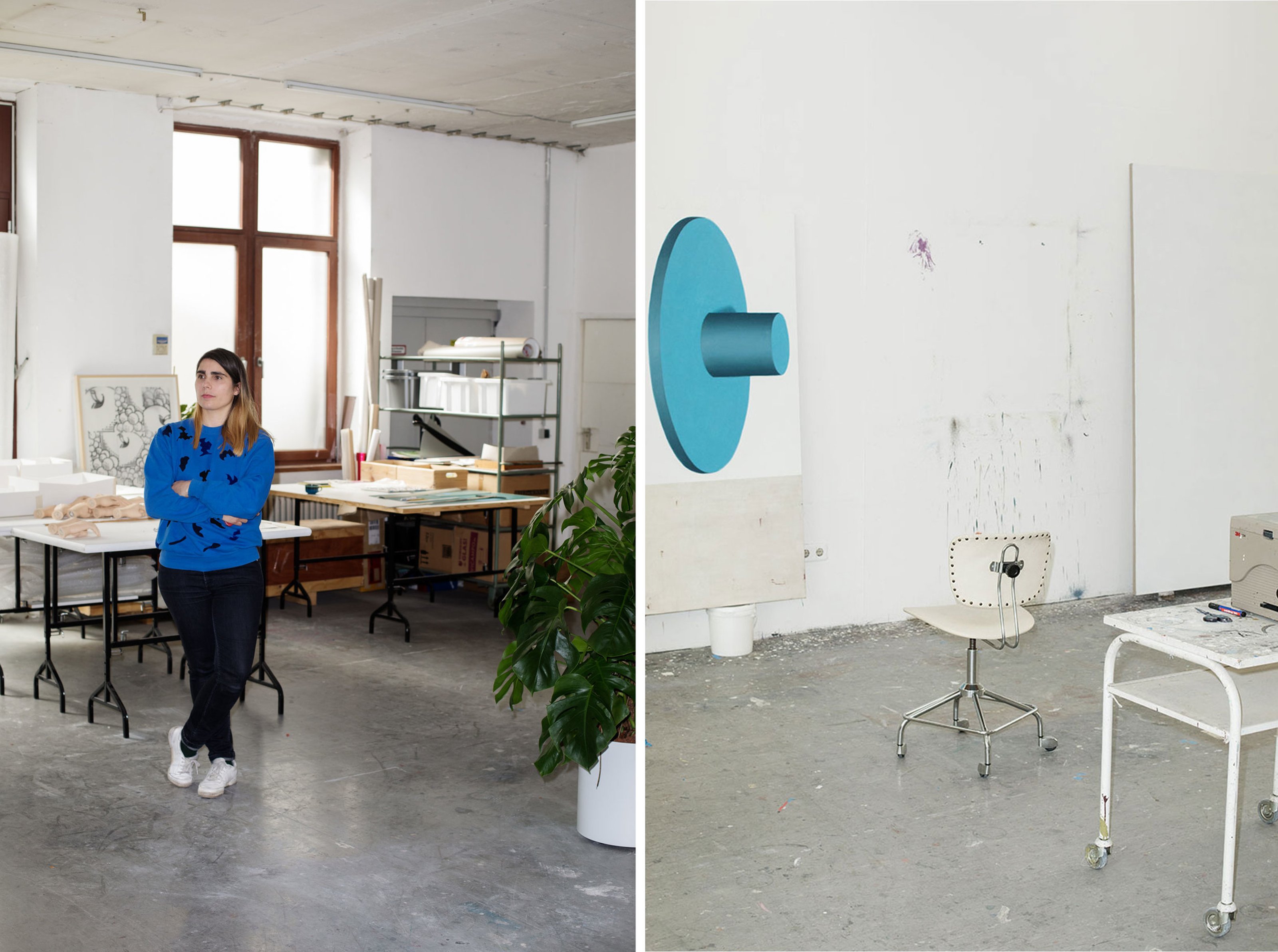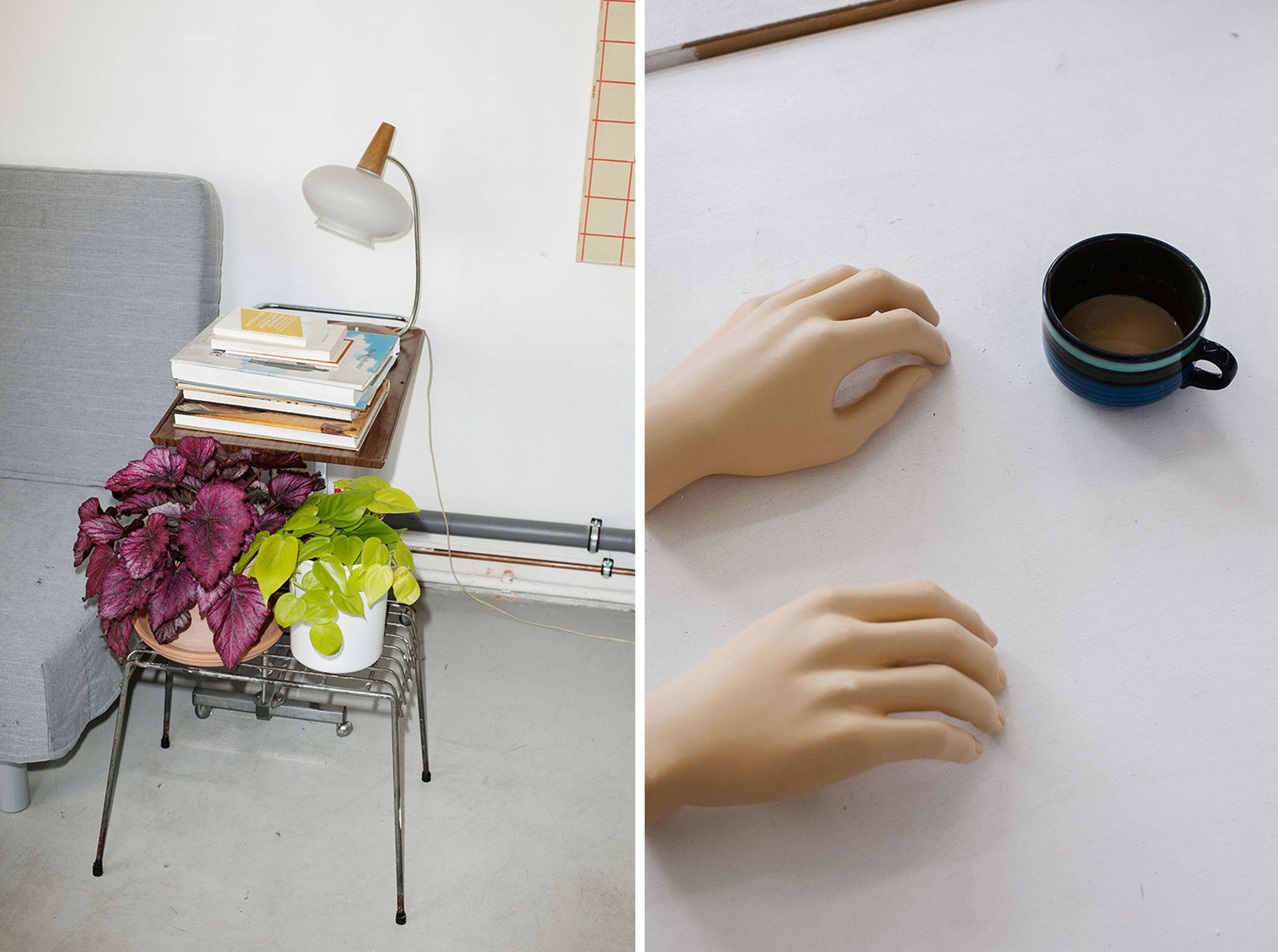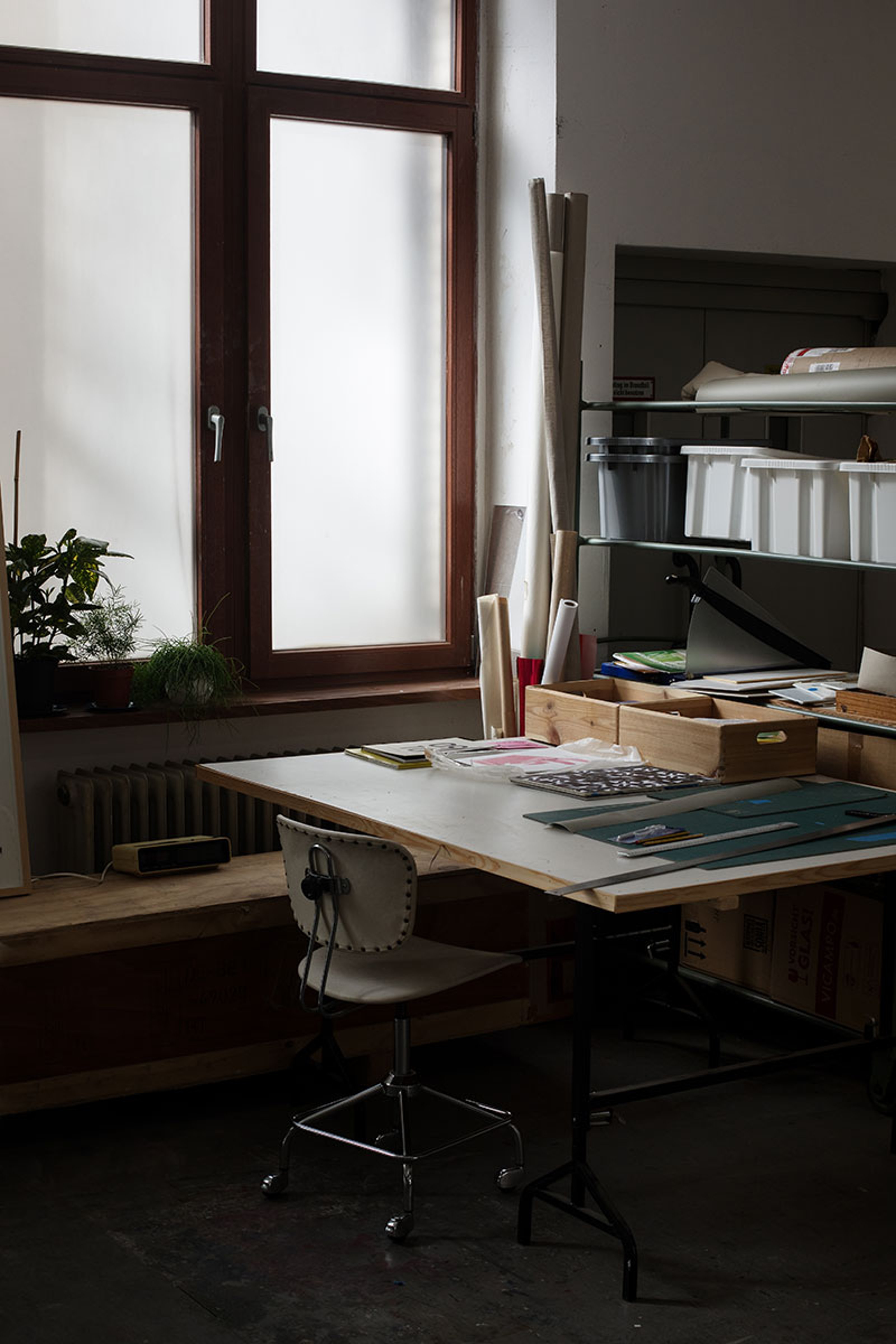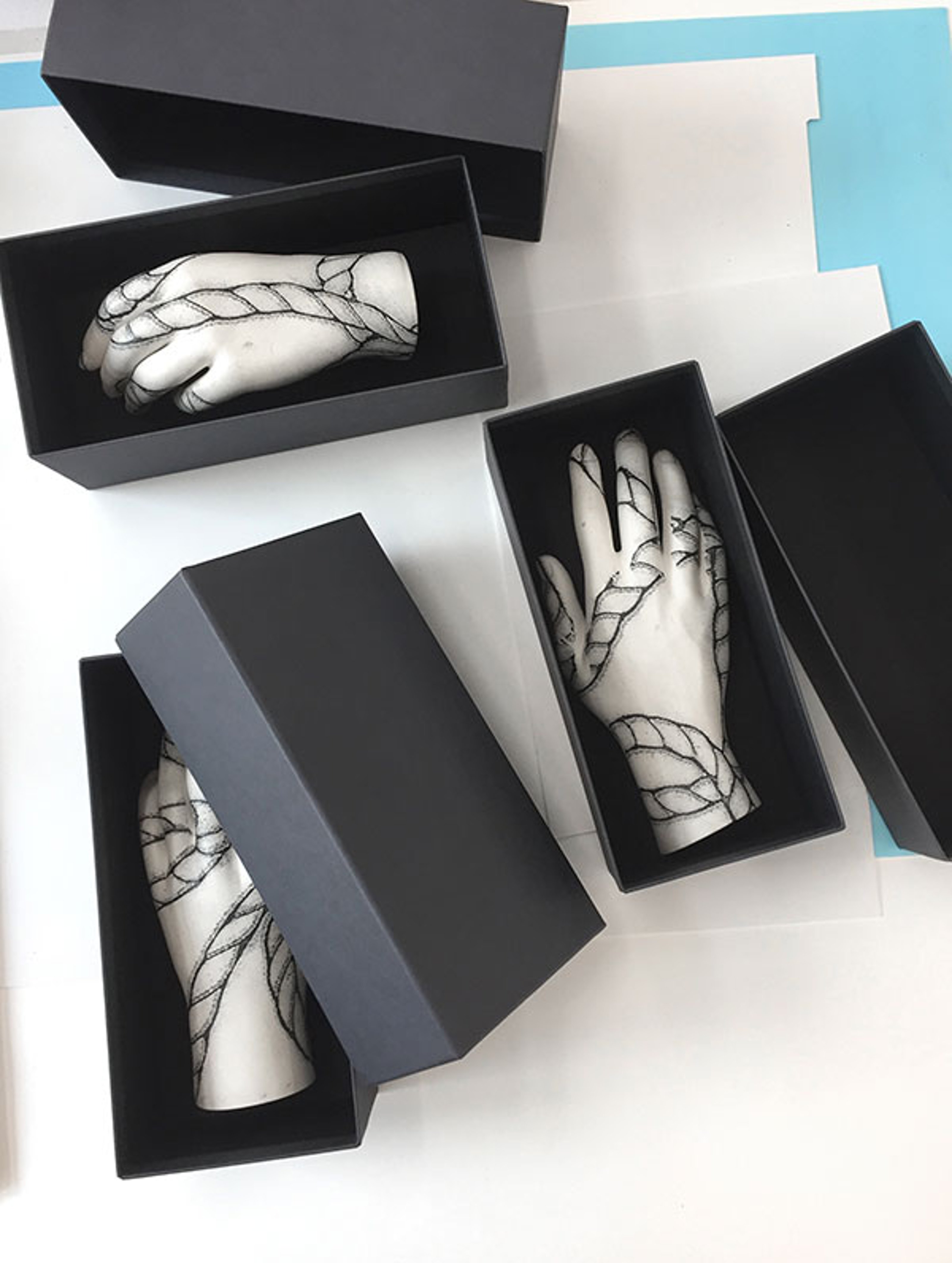
When Anne Neukamp greets us in her sun-spattered Berlin studio, she gives us the type of hug that immediately grants access. Physically experiencing Neukamp’s work for the first time changes things. Offline, the paintings—ranging from small- to large-scale—automatically inhabit the viewer’s entire attention; somehow they offer no escape. It’s especially their aesthetic autonomy defined through the arrangement of color and abstraction that leaves us groundless. A decryption game begins in which well-familiarized icons and objects have been deconstructed in form, putting the viewer into a trance that steadily moves back and forth between memory and confusion.
Above all, it’s the transformation that matters in Neukamp’s practice. New possibilities come together on a three-dimensional landscape, making us question the past and what it means for memory.
Collecteurs: I’m glad we were able to meet in person. Even though, our exchange via email was very constructive.
Anne Neukamp: Yes, it gives you time to think about things carefully. I mean, I’m sure there are artists who are well practiced in having a dialogue. But as a painter you’re alone most of the time. (laughs)
C: It’s just great to physically experience your work in person; it changes things.
AN: That’s the problem with seeing the works online versus in real life. It’s impossible to experience painting fully on screen. Most of the elements used in my paintings are originally part of screen life. Yet through their transformation into painting and their change in size, there’s a different impression; exactly what gets lost when seeing the works online.
C: Yes, online the works look very slick.
AN: An impression I consciously mimic. But in the end, if you come close, it’s still a painted image and not perfect at all. I like that.

© Christoph Mack for Collecteurs
C: The elements in your work often include popular imagery; for instance, logos of brands. Their previously programmed content is removed through exaggeration or alteration of their original structure. Its memory, however, remains within the viewer; something that I’d like to assume is intentional. It somehow proves our subconscious manipulation of consumerist culture, how we sense brands without even entirely visualizing them. It’s like they’re almost inside of us. Do you want to raise awareness about consumerism?
AN: This kind of imagery tells a lot about the way we generally communicate and how we imagine — or don’t imagine — things. How certain automatisms and reflexes structure our daily life.
I was always fascinated by the visual attributes and characteristics of these images, their pictorial abbreviations that can effectively leave a mark on memory.
In my paintings I like to bring these visual codes into play, with all their metaphorical or psychological potential, all the while not always knowing where I’ll end up. Usually I need time myself to understand my paintings; often, and at best, they keep puzzling me.
C: The fact that you need time to understand your paintings also suggests that some choices or actions are made unconsciously. So while your ‘confusion’ contributes and takes part of the process, the notion of ‘consumeristic images’ having been deeply memorized is yet again asserted, and heightened.
AN: When I start a painting I like to keep it open-ended, but that doesn’t mean that artistic choices are made unconsciously. It’s more about the visual mechanics and reflexes that get addressed by certain elements; and that can be very complex.
Once a painting is done, I need time to gain some distance. I need to let things cool down in order to review the work, and see how it affects and activates me as a potential viewer. If I understand it too quickly, I most probably won’t keep it.
C: Do you see some kind of beauty in the way our memory is manipulated by these contemporary visual languages, within this overall consumerist process?
AN: In contrast to the rather linear dimension of the written word, images can be received in a very instantaneous and direct way. The visual and cognitive get touched at once, without distance. That’s why their impact can be so powerful.
Functional imagery of visual communication uses this immediateness. It’s very efficient and quickly recognizable, creating a closed circuit between intention and expectation. At the same time it’s kind of detached from what it actually depicts. Painting a 3D modeled object, for instance, let’s say a key, means something completely different than painting a key after an existing model that has a real measure and that might even be able to open a door. The digital image of a key is calculated. The physical and mental space that it is supposed to open is pure projection, and almost absurd.

© Christoph Mack for Collecteurs
C: Using these deeply-memorized images of societal-existence, is it also a lot about nostalgia?
AN: Maybe we could rather address the melancholic aspect, related to a certain emptiness or absence of immanence that often goes along with economical communication. These images can be like pure envelopes, detached from concept or imagination. But there’s no sentimentality in the work, so I don’t think it’s about nostalgia.
C: I’d like to know more about your time in Dresden, where you studied. An education in art can be problematic, considering professors at times just want to execute their very own ideas and style onto their students.
AN: Right, Dresden was very different back then; it was 11 years after the reunification. My experiences, especially during the first 2 years, were quite influential in terms of my development as an artist. Before moving there, I didn’t know much about the east. Though I had family in East Berlin, my parents never took us to visit them.
I was in Düsseldorf for two semesters with Helmut Federle, and had planned to apply. But then I visited Dresden, and decided to follow my gut feeling, and stayed.
The contrast to a typical West German school, like Düsseldorf, was huge. Most of the professors were from East Germany and had already taught during the former GDR; one could still very much feel the imprint of a different political and social system. The way they spoke about art was so different, somehow almost like another language. Things were often said between the lines.
My education was rather classical, especially in terms of technique, which I often hated during that time. But in the end, I learned to love it, because it gave me a strong base to build from.

© Christoph Mack for Collecteurs
C: The aspect of art history is interesting here, how it must have varied from west to east…
AN: It’s a lot about perspective, I guess. I was introduced to artists that were very active and influential in the East, but who had no importance at all in the West.
Interestingly, even though they had their own scene in the East, they were always aware of what was going on in the West – that was not necessarily the case the other way around.
C: Are you still connected to Dresden?
AN: Not the city itself, but some of the artists. Dresden wasn’t a city where artists stayed. They all went to Leipzig or Berlin.
C: Is it really that important to move to a larger city?
AN: In my case it was. As a city, Dresden is a special place; it’s complex and interesting on many levels. But I couldn’t live there as an artist. It might be the very present nostalgia related to the city’s trauma of destruction towards the end of the war. It manifested in the way that the entire city got heavily restored, turning it into a kind of external museum. It often just felt too backward-looking.
C: Though, it must have been somewhat helpful to attend your practice without the art market being in your face 24/7.
AN: Yeah, studying there was great, it was completely absent from the art market. There was one gallery, that’s it. First develop, and then see what happens. It was a type of shelter, definitely.
C: It’s important to have the time and space to find your own voice as an artist. But I guess there was also a downside to all of this: no network.
AN: Nothing, and that made things difficult at the beginning. I probably should have done a masters somewhere else, but I just didn’t think that strategically…
C: But who does? It’s mind-boggling when a 22 year old artist has an entire plan already laid out. It turns their entire practice into a business plan, and how genuine is that… So, what did you do after finishing school?
AN: I opened a project space with my now-husband. We organized exhibitions for three years in Kreuzberg. We’d curate an exhibition every six weeks, which eventually built an amazing network of artists. It was a great experience.

© Christoph Mack for Collecteurs
C: Returning briefly to Dresden’s post-war nostalgia, do you think it somehow affected your direction as a painter and human?
AN: I spent 5 years in Dresden, at a time when everything was sort of shifting; the former GDR was also still quite palpable. It was especially the differences in the way we interact and communicate — which I mentioned earlier— that made it clear to me how a system (whether it’s socialist, capitalist, or another kind) influences our communication. I realized that the system you live in and might take as a given, can also suddenly change.
C: Can you show me around your studio? What are you currently working on?
AN: I’m in midst of finishing the last paintings for an exhibition. I’m also working on my first institutional exhibition in the US, which will take place at the Rosenwald-Wolf Gallery of the University of the Arts in Philadelphia.
C: These are mini models of the gallery space?
AN: Yes, it helps to have an overall perspective, to see what’s possible, and especially what isn’t possible. The studio is big and I can try out many things. But these models help to visualize it all together.

Mannequin hands pre-dip for Collecteurs Capsule Editions © Christoph Mack for Collecteurs
C: Is it important to be part of the curation process?
AN: To me hanging is another part of the work and I really like to be part of that process. Through placing the works you can create a connection, a dialogue between them. They are all related, but aren’t conceived as a series. Each painting has its own logic. So, how they come together is crucial.
C: Your practice largely revolves around the image, what it means, and what is expected of it. Do you think an image solely produces meaning when it’s being watched? In the end, does an image need to serve a type of purpose?
AN: I think the production of meaning is very much related to perspective and context. While you might see a particular thing inside an image, I might see something else. Everyone has their own experiences, and interests in seeing what we want to see.
Viewing habits and automatisms, though, play a role too. We only see what we’re used to seeing. There’s a certain cultural and aesthetic ground, common visual codes that imagery of communication and technical images especially operate with. I don’t think these types of images have a meaning per se, but rather produce meaning when being looked at.
C: The titles of your work usually have several meanings, referencing the multiple meanings of a painting. This type of introduction loosely implies that you don’t want or need your audience to attain one particular message or thought. When choosing a polysemic title, do you want every meaning to be equally present? How do you want the viewer to walk away from your works? With a message or a sensation, or neither?
AN: The titles have a rather associative character and may just underline the ambiguous nature of the paintings themselves that consist of different painting techniques and idioms.
I don’t want to give instructions, nor place a specific message. I’m interested in the activated state of a gaze that somehow rests in this state of ‘in-between;’ a place where things could potentially flip into any direction.
C: Yet you do place a certain fixed message or instruction— at least narrow down its possibilities—when applying details of specific cultural icons. So in a sense you do want us to take away a message. Perhaps you want us to experience confusion, drifting off into unpredictable directions, but it’s curated. To an extent, at least.
AN: Yes, you can put it like that. Things are placed on the table, curated as you say, and the viewer has an active part. While using these details of implied elements, I like to reach a situation where the clearly recognizable gets kind of pushed ad absurdum, towards an uncertainty or confusion, if you want, that keeps you in motion, looking. I think a great thing about art is that it’s not about transporting explicit messages or giving comfortable answers to lean on.

© Christoph Mack for Collecteurs
C: Standing now in front of the paintings, I can see the stark difference between experiencing your work physically versus virtually. From afar the sleekness is still there; but the closer one gets, the more imperfect they become, and they almost turn abstract.
AN: Like with most art, and especially with painting, it is very important to see it in real life, to experience the physical presence of it. As we already said earlier, the discrepancy between an illusionist, perfect impression from afar and the closer look that confronts you with the concrete material and that makes everything more abstract is very relevant. That’s why my paintings are usually of a certain size, to amplify this impression.
C: There’s the particular attraction to the inanimate figure, objects that appear in daily life.
AN: Yes, in my most recent paintings there’s an increased attention towards images of clearly recognizable objects; banal objects from daily life, which can have a metaphorical level and are represented in a simplified, kind of objectified manner, due to the image’s digital origin. They are mostly simple 3D animations.
C: In painting, particularly its history, artist often seemed interested in portraying living things like humans, plants, food. You, on the other hand, make these technical drawings.
AN: These technical images are a starting point, and I transform them into painting. To me, that’s a very living matter.
C: Over there is the Capsule Edition, right?
AN: Yes, in this edition two of my recurrent motifs—the hand and rope—merge into a three-dimensional object. Since I usually work in two-dimensions, I’m quite excited about it.

Anne Neukamp’s Capsule Edition for Collecteurs © Collecteurs
C: How did this 3-D dimensionality come about?
AN: I was at the copy shop, making some black and white copies of source images. I asked myself, what would happen if I put my hand in the copying machine, if a hand were to replace the paper? The photocopied image of the rope was applied via water transfer onto the mannequin hands. It’s a really fascinating procedure. The object is dipped into the image, which is floating on the surface of water. During this process the image gets slightly distorted, and the way it wraps around the object changes each time.

C: Where did the mannequin hands come from?
AN: I got them from a weird Dutch online shop for museum mannequins. As I didn’t want to make a sculpture in the classical sense, taking the mold of my or someones else’s hand, I went for the most banal existing model and chose 9 different mannequin hands to make the edition.
C: So it’s crucial that these materials have already existed beforehand…
AN: Yes, as it’s all about the transformation and how things come together.
C: You recently deleted your Instagram account. What wasn’t working for you?
AN: Right, my Instagram excursion didn’t last very long. (laughs) I’ve never been into social media, so I wanted to try it out. After a few months, I deleted my account. It just felt needlessly time-consuming. I also didn’t really like to look at art through that format.
C: Yet it’s become a popular way for people to discover your work. Do you find it personally troublesome how people spend more and more time experiencing your work via social media? Has there been a positive impact aside from your work reaching a wider, international audience? Especially considering the elements in your painting often stem from digital form.
AN: People discovering art might be a positive aspect. The question, though, is how they discover it. Looking at an artwork on Instagram is like looking at an image of art; a sort of abbreviation that looks very nice and determined — and that might not at all be the case in reality. The mechanisms of presentation on this platform make everything look almost the same, forced into line. The gesture of scrolling through felt kind of indifferent, almost spoiled…
I use elements that are often of digital origin. Yet, they get deconstructed and transformed into painting, a very physical and tangible medium that has to be experienced in real life. I guess this is one of the reasons why it’s so appropriate to reflect on these questions.

End.
Photography by Christoph Mack for Collecteurs